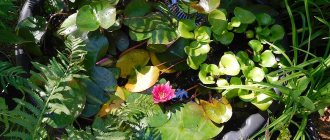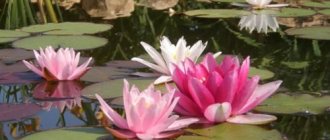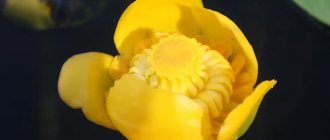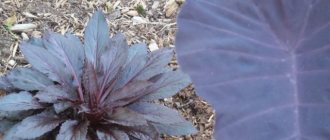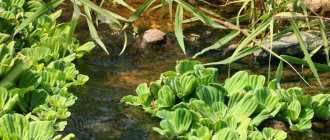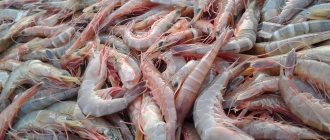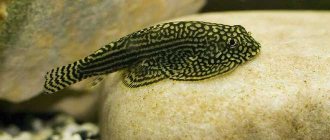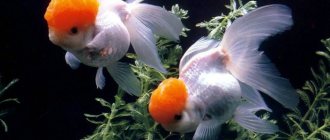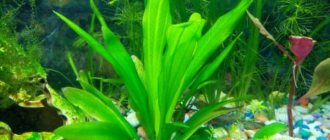Artificial ponds can be decorated with different plants, but the nymphea looks best in them; planting and caring for it in a pond is simple and does not require a lot of time and effort. There are several varieties with which you can create an original composition.
Content
- 1. Description 1.1. Popular varieties and varieties
The genus Nymphea belongs to the water lily family (Nymphaeaceae). There are about 50 varieties of Nymphaeums. Among them there are cosmopolitans that take root in fresh water bodies from South America to the tundra: Nymphaea tetragona, Nymphaea alba, Nymphaea candida.
Nymphs are able to grow, bloom and bear fruit with a significant decrease in water level and even on land. For this they are called amphibious plants.
Distributed on all continents of the globe. In ancient times they were often mistaken for Lotuses. The famous Egyptian lotus is actually Nymphaea lotus. The Red Indian Lotus (Latin: Nymphaea rubra) and the Nile Blue Lotus (Latin: Nymphaea caerulea) are widely known. In Rus', the dried rhizome of Nymphea was called overcome-grass and was worn as a talisman.
How to plant a nymph
When planting, consider the depth of the pond or container. If the depth of the pond for the nymph is about 70 cm, then the planting depth should be 50 cm. In addition, the foliage floating on the surface of the water should occupy no more than a third of the water surface. If the pond is completely overgrown with lilies, then you will end up with a flowerbed, not a pond. And the pond looks better when there are stripes of water between water lilies of different varieties, so don’t plant the flowers too close.
Water lilies do not like fast flows or sudden fluctuations in water levels, so do not plant them near fountains.
The easiest way to grow a nymph is from a division (part of a rhizome with a bud). In this case, each of the divisions is planted in a separate container (a container or a black plastic basket) with small holes in the walls. For dwarf varieties, a wide and not very high basket of 5 liters is suitable, and for large ones - 10 liters.
A mixture of clay, sand and garden soil (in a ratio of 2:1:1) is suitable for planting water lilies. You can add special fertilizer for the pond (according to the instructions) or bone meal.
Water is added to the substrate until it reaches the consistency of thick sour cream, after which a division of the nymph is planted in it, and the soil is sprinkled with pebbles (2 cm layer) on top, without covering the growth point. Then the container with the planted water lily is placed in a pond or bucket (when growing dwarf specimens).
It is recommended to plant nymphea in May, then already in July the first few flowers will appear on the plant. At the same time, every 3-4 years the bushes need to be divided and replanted, since due to crowding they stop blooming.
Description
Aquatic herbaceous perennial 60–250 cm high. It grows up to 200 cm in diameter.
The rhizome is thick, tuberous or horizontal, immersed in the bottom substrate. The diameter of the rhizome is 4–5 cm. The root hairs are numerous, located in the nodes of the rhizome.
IN THE PHOTO: Nymphea rhizome. Photo by Arthur Haines.
The leaves are attached to elastic and durable petioles. In some representatives of the genus, the length of the petioles reaches 5 m.
The emergent leaves are rounded and heart-shaped. Length 12–30 cm. The color of the emergent leaves varies from dark green and green-silver to burgundy with spots. The leaves located under water are broadly lanceolate, covered with a film. Membranous underwater leaves cover the growth buds of the plant with developing pedicels and leaf petioles.
IN THE PHOTO: Thanks to the long petioles of Nymphea leaves, the leaves move along the surface of the water without being damaged by the flow and fluctuations of the water. Leathery and dense leaf blades are protected from getting wet by a wax coating.
Flowers are 3–25 cm in diameter. The arrangement is floating or protruding. The shape is star-shaped, spherical or cup-shaped, with four to five green sepals, a fused-petalled corolla and a thick star-shaped style. Less commonly, Nymphaeum flowers are chrysanthemum-shaped, tulip-shaped, goblet-shaped or ray-shaped.
IN THE PHOTO: Flower of the 'Siam Purple' cultivar.
Flower colors are white, cream, yellow, pink, orange, red, bluish-violet. The flowers of most varieties exude a delicate, pleasant aroma.
Nymphea flowers open in the morning and close in the evening. When there is a sudden cold snap, they do not bloom and go under water.
The fruit is a berry-shaped, spongy multi-leaflet. Each fruit contains 1600–1700 seeds. After ripening under water, the fruit disintegrates. The seeds float to the surface and are carried by the current, birds and aquatic fauna.
Popular varieties and varieties
In the middle zone, frost-resistant varieties are mainly grown. Many of them were bred by the French breeder J. B. Latour-Marliac.
IN THE PHOTO: Cultivar 'Lucida' bred by J.B. Latour-Marliac in 1894. Photo by Alice Galante.
Dwarf varieties are popular for growing in aquariums and other indoor ponds: 'Pygmaea Rubra', 'Pygmaea Helvola', 'Pygmaea Alba', 'Aurora'. These cultivars are tolerant of hard water and small amounts of alkali. The compact and easy-to-maintain Nymphaeum tetrahedral is also suitable for indoor spaces.
IN THE PHOTO (from left to right, top to bottom): Compact Nymphaeas of the varieties 'Pygmaea Rubra', 'Pygmaea Helvola', 'Pygmaea Alba' and 'Aurora'. Photo by Alice Galante.
Owners of small garden ponds prefer medium and small varieties of Nymphaeum, especially Laydeckeri hybrids, hybrids of K. Leydecker. This is 'Gonnere', aka 'Snowball', 'James Brydon', 'M-me Wilfon Gonnere', 'Perry's Fire Opal', 'Rose Arey', 'Marliacea Chromatella'. Leidecker hybrids are distinguished by small leaves, lush and abundant flowering. The diameter of mature specimens is up to 60 cm.
IN THE PHOTO (from left to right, top to bottom): Leidecker hybrids 'Gonnere', 'James Brydon', 'M-me Wilfon Gonnere', 'Perry's Fire Opal', 'Rose Arey', 'Marliacea Chromatella'.
Photo by Alice Galante. The variety Nymphaea odorata 'Alba' grows well in mini-ponds. It is considered one of the most winter-hardy.
IN THE PHOTO: Nymphea fragrant 'Alba'.
The highly decorative and unpretentious 'Marliacea Rosea', 'Marliacea Cornea', 'Attraction', 'Gladstoniana', 'Escarboucle', 'Hollandia' have become common varieties for reservoirs with a depth of more than 60–80 cm. A popular European variety, Nymphaea alba, is also grown in deep ponds. It is notable for its decorative leaves with a green top and purple-red “underside”, and double white flowers with a bright yellow center.
IN THE PHOTO (from left to right, top to bottom): Large-flowered varieties Nymphaeum 'Marliacea Rosea', 'Marliacea Cornea', 'Attraction', 'Gladstoniana', 'Escarboucle', 'Hollandia'. Photo by Alice Galante.
Maintenance and care in the aquarium
First of all, it is worth noting that to keep a nymph you will need a large aquarium, at least 250 liters. Its large leaves will block the light, so proper placement of the rest of the vegetation will be required.
The water lily prefers warm water. The optimal temperature for its comfortable maintenance should be within 25-28 degrees. If it drops even a couple of degrees, the growth of the nymph will stop, and flowering will not occur at all.
With increased rigidity, the water lily produces many small leaves under water and turns into a bush. In such conditions, it practically does not bloom, so if you want to see water lily flowers, you will have to soften the water. It is also necessary to maintain a slightly acidic balance and a high concentration of humic acids. Simply put, frequent water changes will not be required.
Nymphea prefers a lot of light. Otherwise, it fades, the cuttings lengthen, and the plant itself loses its special shape and structure, growing chaotically. The ideal light for water lilies is the sun's rays, but in aquarium conditions you can install fluorescent fluorescent lamps. The power is selected based on the calculation of 0.5 W per liter of volume. Such lighting is actively used in greenhouses and greenhouses. They can be replaced with special phytolamps.
It is not recommended to use incandescent lamps as the main light, because their power will not be enough. In addition, they heat the water. They are installed as an additional source of rays of the red-orange spectrum. In order to achieve flowering of a water lily, you will need to maintain a daylight hours of at least 12 hours.
Suitable soil for nymphs is a silted substrate that contains a large amount of organic matter. Despite the fact that the roots of the plant are powerful and strong, they are very vulnerable and can be damaged by sharp stones. Therefore, it is better to use small pebbles. Clay, charcoal and peat are added to the soil as fertilizers.
In order to achieve flowering of a water lily, you will need to maintain a daylight hours of at least 12 hours.
In order to grow a healthy and strong plant that is capable of blooming, you can plant nymphs in separate pots:
- Pebbles are poured onto the very bottom of the container;
- Next comes a layer of soil. It consists of substrate, sand and clay;
- A nymph is planted in the ground;
- The remainder of the container is filled with pebbles and coarse sand.
This method of separate planting allows you to achieve the correct soil composition and the development of a powerful root system that will not be oppressed by other flora.
We recommend reading the article: Aldrovanda vesiculata - a swimming predator in the aquarium
Growing
In room culture:
To grow Nymphs indoors, you need a container or a special basket for aquatic plants, 25–30 cm high and 30–60 cm in diameter. The container is filled with a mixture of peat, sand, humus and sapropel 1:1:1:1. Mineral fertilizer for Nymphs is added to the soil mixture.
The rhizome is placed in the ground at an angle of 45°, so that the growing point is at ground level or slightly above. The planting depth for container plants is 20–40 cm. Then the soil is soaked and covered with gravel.
IN THE PHOTO: In addition to gravel, small river pebbles are suitable for mulching the soil around Nymphea.
At first, the container with the Nymphea is placed at a depth of 20 cm under water. Then, as the leaves grow, the immersion depth is adjusted to that recommended for the variety.
It is advisable to slightly acidify the water for Nymphea. Read more about the use of acids for this and other purposes in the publication: “The use of citric, succinic and malic acids as regulators of plant growth and development.” Be sure to soften and pre-filter the water.
Indoor Nymphea is kept in a well-lit place at an air temperature of +24–28°C. When the temperature drops to +22°C, Nymphea grows more slowly and does not bloom.
PHOTO: Red-leaved species, such as this Nymphaeum 'Red Tiger Lotus', require more light than those adapted to mid-latitude conditions. To prevent exotic varieties from going dormant and losing their decorative properties, artificial lighting will be needed.
Bone meal is recommended for fertilizing Nymphaeums in closed containers. To prevent the fertilizer from being washed away by water, it is mixed with clay, molded into balls the size of a tennis ball and placed under the rhizome when planting the plant. Granular fertilizers for aquarium plants are also suitable.
In garden ponds:
Adapted to the conditions of mid-latitudes, Nymphaeums grow in any garden pond with filtration, circulation and aeration of water.
IN THE PHOTO: Nymphs look great in ponds of various designs. Small design tricks, such as evening lighting, give their decorative foliage a fabulous look.
It is important to equip a pond with Nymphaeums with a drain and an influx of new water to prevent stagnation and “blooming” of the reservoir in the hot months. Nymphs feel good in standing water, but it is advisable to change 5–10% of the pond contents weekly.
The illumination of the reservoir is important: in a heavily shaded pond, growing Nymphaeums is difficult.
Plants are planted no thicker than one specimen per 0.5–4 m2. There are two options for placing the Nymphea in a garden pond:
- in a container;
- planting in the ground, exclusively for water bodies that do not freeze in winter.
In the first case, the container with the plant is placed in the pond after the air and water temperatures stop falling below +18–20°C. It is more convenient to place Nymphaeums in a partially filled reservoir.
Deep-sea species are planted in the ground. To preserve the rhizome in winter, a place at maximum depth is selected. In order for the Nymphea rhizome to take root and not float up, the soil at the bottom of the reservoir must contain silt and clay, preferably white.
Planting is carried out in May-June as follows:
- The rhizome is freed from damaged areas with root hairs shortened to 5–7 cm, and sprayed with water.
- Planting material is buried into the soil at an angle of 45°. For medium-sized varieties, holes 60–80 cm deep are needed, for large ones 80–150 cm. The growth point is left at 1 cm above the ground.
- The planted plant is fixed with stones.
- The soil around Nymphea is mulched.
If the growth of Nymphaeums in the pond is stable, special fertilizers are not required. When growth slows, plants are fed with complex mineral fertilizers in granules. Organic fertilizing, for example, vegetable compost, is also acceptable. But too much organic matter in the pond can cause root rot.
Nympheas - description and characteristics of the plant
A white water lily in a pond is a classic decoration for ponds in parks and recreation areas, as well as in home areas. This is a perennial plant of the Water Lily family, which has a huge number of varieties. It has round, bright green leaves that can reach up to 40 cm in diameter and complex, symmetrical flowers. They can be painted in any shade, but in nature the white water lily is more common.
Pond nymphs must meet several characteristics, which are important to pay attention to when purchasing:
- frost resistance - some exotic varieties do not tolerate wintering, but they can be grown in containers and hidden in a warm room from low temperatures;
- root length - selected in accordance with the depth of the pond, the rhizome of a water lily can reach from 20 to 100 cm or more;
- high-quality planting material - for landscaping a pond, it is recommended to select a ready-made plant, since growing from seeds will be more labor-intensive.
The period when water lilies bloom on the pond lasts from July to September. However, the lifespan of one flower is no more than 4 days.
Reproduction
Vegetative technology:
Vegetative propagation is preferable to preserve varietal characteristics. It is better to propagate Nymphea vegetatively from early spring to mid-summer.
A rhizome with several growth points is taken. Wash thoroughly, removing old leaves and stalks. It is cut into pieces with a sterile knife so that at least one growth point remains on each piece.
The sections are sprinkled with charcoal. After this, parts of the rhizome are placed in containers with a suitable substrate and immersed at a shallow depth for germination. As the plant grows, the container goes deeper.
Plants obtained by vegetative methods bloom the following year.
ON VIDEO: The secrets of the Nymphaeum division are revealed by biologist, founder of the unique Russian Water Gardens Park Alexander Marchenko.
From seeds:
Species Nymphaeums are mainly propagated by seed method. Nymphs are sown in winter or early spring in pots with substrate. After this, the containers are immersed in water at a temperature of +25°C and left in a lighted place.
If Nymphs are sown in an aquarium, there should be no herbivorous fish or snails.
After the seedlings appear and grow, they dive. In the future, young plants are cared for in the same way as adults. In the second year of life of Nymphae grown from seeds, flowers appear.
Nymphea tiger or water lily lotus
Nymphaea tiger or water lily lotus
Nymphaea tiger or water lily lotus (Nymphaea lotus) is a very beautiful plant that can be kept both in an aquarium and in a pond. A favorite plant of aquarists. On long thick cuttings very beautiful underwater leaves of a round shape with a heart-shaped cut appear. Their color is variable; dark green tones with brown, reddish, and purple splashes predominate.
On long thick cuttings it has beautiful underwater rounded leaves with a heart-shaped cutout. The color of the leaves is variable: dark green with brown, reddish, purple splashes.
Before flowering, the nymphea develops floating leaves that repel water due to their bloom.
Nymphea lotus is demanding in terms of maintenance: clean water with medium hardness is required. Comfortable water temperature is 24-27°C. Nymphea does not like sudden changes in maintenance parameters. As a top dressing, it is recommended to place fertilizer tablets under the roots of the plant. It is difficult for the plant to adapt to new conditions and often loses its leaves.
Nymphea tiger or water lily lotus
Nymphs, or water lilies, can be a real decoration of an aquarium. But they need an eye and an eye. You gape a little and instead of a beautiful bush you contemplate the petioles of floating leaves reaching towards the surface. And to prevent this from happening, it is necessary to mercilessly cut off the scout leaves of the nymphs.
Nymphea tiger video review
Aquarium magazine 1999 No. 4.
It is probably difficult to find an aquarist today who does not know about tropical water lilies - tiger nymphs (Nymphaea lotus var.). These plants are widespread in Russian and European aquariums. The extraordinary and rare beauty of nymphs captivates at first sight and gives rise to the desire to cultivate them in your own home ponds. The exact definition of the homeland of water lilies is still the subject of scientific debate. Currently, “wild” tiger nymphs are found in tropical Africa and Asia and are the most heat-loving of the water lilies (Numphaeceae), a large family whose representatives live at almost all latitudes from the equator to the forest-tundra.
Nymphea tiger or water lily lotus photo
The popularity of tiger nymphs among aquarists is easily explained. Firstly, they are easy to maintain: secondly, they grow actively all year round; Thirdly. reproduce abundantly vegetatively; and, finally, fourthly, in terms of the beauty of underwater leaves (which is especially valuable for decorative aquariums) they leave far behind the rest of their “relatives”. But in the pools, speckled beauties cannot keep up with most of their “older” and larger “sisters” in the splendor and beauty of above-water leaves and flowers.
There are two main forms of tiger nymphs - red-leaved and green. In the first, the color of the leaves varies from dark red to cherry color, in the second - from light green to dark green. The conditions of detention for them are identical. Perhaps the green nymph is a little less capricious, adapts more easily and endures unfavorable conditions more steadfastly.
Nymphea tiger or water lily lotus photo
The nymphs received their common name - “tiger” - for the distinct, chaotically located burgundy spots of different sizes, scattered along the upper and lower sides of the leaf blade (in the red-leaved form they are somewhat darker). The lower surface of the leaves has a light purple color, clearly visible on bushes removed from water in natural light. Artificial light makes the purple tint invisible, and the reverse side of the leaf becomes similar to the front side, only a little paler.
Green nymphea has selection forms with the lower surface of the leaves the color of a strong solution of potassium permanganate. Unfortunately, they are rare among Russian aquarists. The leaves of tiger nymphs are cup-shaped, open-ended, with a characteristic acute-angled cut, reaching the point where the petiole transitions into the leaf blade. In young plants they are almost flat, almost regular oval in shape and smooth at the edges; the incision is hardly noticeable due to the tight closure of the “wings”. The leaves of mature bushes have concave, wavy edges and a deep V-shaped notch at the base.
Tiger nymphs are cultivated only in a submerged (submerged) state. The height of adult bushes indicated in most literary sources - up to 50 cm - is clearly underestimated: I have more than once observed and grown huge bushes of both forms more than one and a half meters high, with leaves the size of a soup plate and dark brown petioles as thick as a pencil. By the way, it is gigantism, characteristic of most water lilies, that limits the spread of nymphs in compact amateur aquariums.
Nymphea tiger or water lily lotus photo
Today, nymphs are considered the most deep-sea plants of freshwater flora. In nature, some specimens grow at a depth of 3 m (naturally, in open areas of water with high illumination), and if their leaves did not rise above 50 cm, then at such a depth they would have to develop in almost complete darkness - what. Of course, it's impossible. Tiger nymphs are surprisingly flexible. Wild plants live in waters with dGH 0.5-4°, pH 6.0-6.5. However, thanks to the ability to adapt to living conditions, secured by long-term selection, cultivated bushes tolerate dGH well up to 10-16° and pH up to 7.2-7.7. Specimens taken from natural habitats. in such water they degrade and die within a week.
But it was not possible to expose these heat-loving plants to low temperatures: they still prefer a temperature of 26-28°C. Do not frighten them by heating the water to 30-32°C. With sufficient lighting and nutritious soil, this temperature can be maintained all year round, which makes nymphs almost ideal for aquariums with discus fish. The range of 22-24°C is critical for plants, and cooling the water to 20°C even for 2-3 days threatens their death.
Nymphea tiger or water lily lotus photo
Lighting should be intense. Plants are successfully cultivated using fluorescent lamps of the L B and LTB types or their combination with incandescent lamps with a total power of 1-1.2 W/l. The use of only incandescent lamps is undesirable; you can do without them altogether. using phytolamps LF and LFU. The duration of illumination is at least 10 hours a day. Under optimal conditions, nymphs grow quickly, intensively absorbing nutrients from water and soil. Before planting, it is advisable to add a finely molded granular mixture of equal parts of white (blue) clay, boiled peat, lake sapropel and birch charcoal into the soil under the root system. It is better to apply mineral fertilizers in liquid form 2 times a month, after the next water change. As a soil, you can use small (0.5 mm) pebbles or expanded clay of the same fraction. The root system of plants is well developed and occupies a large area, so the thickness of the soil layer should be at least 4-5 cm. The roots of nymphs are not afraid of soil souring due to the accumulation of organic matter. Some authors even believe that water lilies prefer anaerobic conditions for root development. However, no one has yet been able to establish for sure whether this is really the case. Good plant growth was observed both in fresh soil (with pre-applied organic-mineral fertilizer) and in thoroughly acidified soil. Sometimes, when large bushes were removed from the water, the terrifying smell of hydrogen sulfide clearly indicated the functioning of the root system in oxygen-free conditions of actively rotting organic matter.
In other cases, an equally well-developed bush formed an excellent root system in a normal, aerobic area of the soil and did not experience any visible discomfort. Given enough light and warmth, nymphs are very tenacious. Only a temperature difference between water and soil of more than 4°C can knock them out of balance. They also feel no good in newly formed reservoirs with fresh soil and high redox potential. It is better to use vessels that have been in active use for at least three months, in which long-stemmed plants were used for initial planting. It is very desirable to have a large school of fish in the aquarium (preferably viviparous or labyrinthine), as well as ground snails. In general, any heat-loving fish are suitable for reservoirs with tiger nymphs, with the exception of persistent vegetarians and large species that can damage delicate plant leaves.
Young, strong specimens of nymphs with richly colored leaves on low petioles should be used as planting material. Very young bushes with low biomass, thin fragile petioles and pale leaves do not take root well even in optimal conditions and are very critical to high water columns.
Nymphea tiger photo
Transplantation from pond to pond causes a negative reaction in plants (especially in the red-leaved form), which is expressed primarily in a slowdown in growth rates and a decrease in the area of leaf blades. But, usually, after being “ill” for 12-16 days, the plant begins active growth. Adaptation occurs almost twice as fast if the bush is not planted in the ground for 2-3 days, but only lightly fixed with several heavy stones. Transplanting plants within the same body of water, as a rule, does not cause problems. Caring for them practically comes down to removing old leaves, riddled with holes and frayed at the edges, along with petioles. Plants tolerate such operations painlessly and do not reduce growth rates. In aquariums, tiger nymphs reproduce both sexually and vegetatively. Large white flowers can be easily pollinated artificially with a fine-haired squirrel brush and at the same time obtain a sufficient number of seeds. They are planted in low glass bowls with water and a thin layer of soil, providing heating to 27°C and bright overhead lighting. As the seedlings grow, the column of water is raised, and when the young bushes reach a height of 12-15 cm (leaf diameter is at least 5 cm), they are transferred to normal aquarium conditions. Despite the relative simplicity of seed propagation of nymphs, it is rarely used in home reservoirs. The only exceptions are, perhaps, research and selection work. The reason is simple: nymphs readily and very abundantly reproduce vegetatively throughout the year. Under natural conditions, the period of formation of daughter plants begins immediately after the completion of seed fruiting and lasts relatively short. Vegetative propagation occurs by root shoots spreading in the soil at shallow depths. The shoots are sometimes quite long (15-20 cm), and sometimes the young plant sits close to the mother rhizome. Thickets of young trees must be systematically thinned out and planted, since their compact arrangement inhibits the growth of the mother bush, and the teenagers do not allow each other to develop normally.
Nymphea tiger or water lily lotus photo
If the thicket is left undisturbed, then over time the mother bush decreases in size to the level of its daughter bushes: when examining the “birth nest”, it becomes difficult for even an experienced eye to identify. who is the “elder” here? When young plants are systematically removed from root shoots, adult bushes begin to “cunning”, forming daughter plants close to the rhizome: separating them without damaging the mother bush is only possible when both are removed from the water.
In aquarium conditions, tiger nymphs rarely produce floating leaves; This usually occurs in large specimens during a period of short-term shading of the reservoir or with a general lack of light. In both subspecies, these leaves are green (in red nymphs they are dark green with a dirty brown-gray tint), dense, not wetted by water and leathery to the touch. It is recommended to remove petioles with floating leaves, since in an aquarium they are of little benefit to the plant, but they significantly shade the pond. When rearing nymphs en masse, it is useful to remember that their iron intake is much higher than the level typical for most aquatic plants. Only with a sufficient concentration of FeS04 in water do the leaves of both subspecies acquire a thick, rich color: the petioles become darker and stronger, and the overall appearance of the plant improves significantly. Feeding with iron salts is carried out 2 times a month and always separately from solutions of other microelements in order to avoid the transition of iron into the trivalent form, which is absolutely unacceptable for plants. Water lilies are just as active in extracting dissolved high-molecular organic matter from water. This feature is used in the fight against parasitic algae: several large nymphs are able to suppress the growth and prevent the spread of even such invincible pests as Compsopogon. Water lilies completely deprive them of their “elemental base” of humic acids and tannins; As a result, algae colonies wither and gradually die off.
Nymphea tiger photo
This method is simple and environmentally friendly, and the results are much more noticeable than the use of the most effective algecides. By the condition and appearance of water lily leaves it is easy to judge the favorable conditions of their maintenance. If the spectral composition of the lighting is unsuccessful and they are cultivated in excessively hard and alkaline water, the nymphs, as some plant growers put it, “burn.” This refers to a change in the color of the outer side of the leaves and their acquisition of a yellowish-silver tint. In principle, this process is reversible, and when the conditions are normalized, the leaves again acquire their characteristic color. The sensitivity to light common to all plants of the Nymphaeceae family is used by experienced aquarists to control the growth of tiger nymphs. There is a concept of “crush a plant with light”; in practice it looks like this: a nymph bush is planted in an open area of ground under a bright lamp that works exclusively “for it.” The lamp power is chosen to be twice the norm, the duration of illumination is at least 12 hours a day.
Nymphea tiger photo
Under such conditions, the plant forms powerful, bright leaves on short thick petioles; layering on top of each other, they give the bush an unusual, very attractive dome-shaped shape. By additionally increasing the light power, you can even achieve a horizontal arrangement of the petioles, and the bush takes on the shape of a wide, beautiful rosette: while the decorativeness and external proportionality of the plant are completely preserved. Nymphs grown in this way occupy a vast bottom area, which must be remembered when choosing a model for the internal arrangement of a reservoir. You can often hear that green and red nymphs do not get along in the same body of water, just as it happens, for example, between Barclay longifolia and B. periana. This opinion is completely unfounded and is completely refuted by practice. I had the opportunity to grow both forms in the same reservoir and observed a similar proximity in the farms of other aquarists. At the same time, both plants formed large bushes and multiplied abundantly, pleasing the eye with a beautiful color combination.
Cool videos about plants from FanFishki
Subscribe to our YouTube channel so you don't miss anything
PRACTICAL NOTE ON GROWING AQUARIUM PLANTS
This note is posted in all FanFishka articles dedicated to aquarium plants. This is a cheat sheet with a link that will help you grow any aquarium plant and herbalist of any complexity.
Most of the reference materials are located in the Aquascape , we also recommend our brochure: Aquarium navigator for beginners: “Underwater Gardens of Babylon” .
The formula for success in growing plants can be depicted as follows.
First of all, the proper level of lighting is necessary.
(light intensity - Lumens)
Next, the proper concentration of CO2
Further macro-fertilizers and micro-fertilizers
Water parameters, care and quality water changes
The gradation of this formula is based on the degree of importance. Lighting intensity is primary, and then descending. Therefore, if your plants have holes in the leaves, they have sciatica (crooked) or there are problems with algae, then please do not read the “bad advice” - this is chlorosis (lack of iron), this is a lack of potassium... diarrhea, phimosis and endometriosis )
You always need to solve the problem of setting up an herbalist from major to minor. Plants will die more quickly from a lack of lighting than from a lack of Fe and K. Moreover, the latter are always present in one degree or another in the aquarium, but it is difficult to measure their precise value.
Below, let's go from the main to the minor.
Lighting in an aquarium with plants . Remember, the most important thing in light is its intensity (Lumens)! All other lighting characteristics: spectrum, Kelvin, PAR/PAR, Ra... are important, but secondary. There will be no intensity of lighting, there will be nothing. At the same time, the lighting intensity must be balanced - selected specifically for your project (height of the water column, number and types of plants, daylight hours).
Based on the above, choose aquarium lighting primarily by the number of lumens, and then everything else.
Lighting is the most expensive part. The most budget-friendly solution is to install ordinary construction-street floodlights above the aquarium . Fortunately, they are now very thin and aesthetic. And believe me, under them everything grows with a bang, of course, provided that all the other components are present.
In order not to be unfounded, here are photos of our herbalists, which were grown exclusively under LED spotlights or with their presence.
If you want professional lighting or aesthetics. Then you will have to fork out some money. The amounts can vary quickly from 10,000 to 50,000+ rubles for a 100 liter aquarium. For example, in 2021 we switched to professional lighting - ISTA Titan . Yes, not cheap, but the lamps are Achon! We have grown a professional competitive aquascape under them. That’s why we advise you to pay attention to them.
Well, it’s difficult to advise anything, because... Everyone has different needs and capabilities. In this article we talk about the products of our partners - Tetra , Laguna , ISTA lighting .
We tried to briefly and objectively talk about them. Then it's up to you. In any case, we do not really recommend that you pay attention to handicraft lighting assembly from folk craftsmen. Not all, but as a rule, they shove who knows what kind of diodes into such an assembly, assemble it all on their knees... and believe me, more than once on the forum you hear echoes of the consequences of such a purchase. After all, a company is a company. At a minimum, you are given warranty and post-warranty service.
If you are a beginner, your first herbalist, then LED spotlights are your choice. Let's move on, otherwise this note isn't very short =)
CO2 for aquarium plants . The plant is approximately 90% water, the remaining 10% is dry matter. Of that 10%, 46% is carbon. This is why CO2 supply is so important in a planted aquarium.
Plants in an aquarium obtain carbon “from water” - from carbon-containing compounds. But the natural concentration of C-carbon in water is small and is only sufficient for unpretentious plants, but they, and even more so, will be happy with additional carbon feeding. The supply of CO2 can be provided using mash or a CO2 balloon system , lemon juice or other methods.
The best, professional, simple and budget option is to supply carbon dioxide through a cylinder. One thing, however, is the initial purchase of a set: a cylinder, an MG valve, a diffuser…. will hit the budget.
Is it possible to do without CO2, but for a couple of bushes of simple plants ( cryptocorynes , echinodorus , most ludwigias , etc.).
What balloon systems can you recommend? The most budget option is an assembly from craftsmen who sell CO2 systems in VK and on forums. Everything is very high quality.
If you want a branded item, then we recommend the most inexpensive and at the same time high-quality CO2 systems from ISTA (Taiwan) . We have been using them for 5 years and recommend them to you.
On sale you will find two series of ISTA Aluminum CO2 Cylinder cylinders, with horizontal and vertical threads of 1 and 3 liters.
Fertilizers for an aquarium with plants . All fertilizers, of any brand, can be divided into MACRO-FERTILIZERS and MICRO-FERTILIZERS .
Macro fertilizers are nitrate NO3 and phosphate PO4 from which plants take N-nitrogen and P-phosphorus. These are the most important elements after CO2 - C-carbon.
Remember - Redfield's proportion rules . Always keep it under control and everything will be ok. Right, based on our observations, Redfield’s proportion rules only in full NPC proportions. Incomplete proportion - without carbon C does not give good results.
Micro fertilizers . These are all the other less important elements that are necessary for plants (see link). There is no point in putting too much emphasis on them. Firstly, all of them are contained in one quantity or another in tap water and are restored in the aquarium with changes. Secondly, an overdose of micro very quickly leads to an outbreak of algae.
A common mistake made by beginners is not understanding what they are pouring into the aquarium. For example, let's take such a popular and popular fertilizer as Tetra PlantaMin . Read the product summary at the link - it strengthens, stimulates, and gives a chic body shape.
A beginner, without delving into the essence, uses it and gets an outbreak of algae, writes on the forums - “Like, wow, what a bad Tetra.” And the trouble lies not in the drug, but in a lack of understanding of the nitrogen cycle and balance in the herbalist . The beginner has a Redfield bias (let’s say N and P are generally zero) and instead of making up for the lack of these primary elements, he fills the aquarium with Tetra PlantaMin - a micro-fertilizer (iron, potassium, manganese). As a result, going over the micro is only detrimental, because... plants lack the base - nitrogen and phosphorus.
Thus, you must understand what plants lack and understand fertilizers.
How to understand what plants lack? It's simple. Now the market is filled with a variety of expensive and not so expensive aquarium water tests. We recommend inexpensive domestic ones - VladOx drop tests , they are sold online and offline.
We also recommend, let’s not be afraid of this word, innovative domestic UHE tests . They are currently only sold online.
The minimum set of tests for an herbalist is NO3 and PO4. It is advisable to have the entire nitrogen range: NH4, NO2, NO3. As well as kH and pH tests.
Tests help us monitor the situation in the herbalist, but over time it is advisable to learn to see and feel the aquarium for yourself. With experience you need to move away from “convulsive testing”; the best aquarium test and tool is ourselves.
Let's summarize this part. Macro, it’s macro in Africa too. The link above generally contains a recipe on how to make them yourself. If you are not yet ready for self-mixing, then always and everywhere you will find a line of fertilizers from Tetra: Tetra Planta Macro , Tetra PlantaMicro , substrates, root tablets and much more .
Of course, there are many other brands that produce aquarium fertilizers. There is an opportunity, use even ADA products. All markers are different in taste and color. The main thing is to use it with a clear understanding of what you are using it for and what you want to get in the end.
From the professional line of fertilizers, at an adequate price, we can recommend Prodibo (soils, soils, macro, micro, stimulants, etc.).
So, something like a note turns into the Talmud. Which is not surprising - the topic is very broad. One moment left.
Water parameters for aquarium plants. Link1 and Link2 , please look at these articles, they cover the essence quite well.
Here we note that the quality of photosynthesis is influenced by the process of caring for the aquarium: water parameters (kH, pH below 7), high-quality filtration and aeration, competent and timely water changes.
Please study
First steps after purchase
If an adult plant was purchased in a 3–5 liter container, it is not necessary to transfer it immediately. When planting Nymphea in nutritious soil, the substances necessary for its growth last for a long time.
If immediate planting is not planned, Nymphea rhizome is stored at a temperature of +5–8°C in the basement. The container with the rhizome is placed in water so that the moisture reaches the edge of the container. You can store planting material buried in moist soil to a depth of 20 cm or cover it with moistened sphagnum moss.
Medium-sized varieties of nymphs
Medium-sized water lilies have a flower diameter of 15-20 cm. They are planted in a small lake or artificial reservoir to a depth of 30-40 cm. Such water lilies occupy from 1.2 to 1.5 sq.m of water surface.
Medium-sized nymphs are distinguished by a huge variety of varieties with flowers of different colors. These aquatic plants bloom from early summer until frost.
The most popular varieties of this group: Gonnere, Pink Dawn, Lemon Meringue, Hidden Violet.
Secrets of success
It is better to transship the nymphaeum rather than replant it. This is done when the rosettes of leaves extending from the rhizome become crowded.
IN THE PHOTO: A new container is selected for Nymphea, one and a half to two times larger than the previous one.
In order for Nymphaeums to bloom magnificently and annually, the rhizomes are divided every four years. In this case, parts of the roots are constantly sprayed. Even short-term drying should not be allowed.
To preserve the decorative appearance and health of the plant, you need to constantly remove old, brown or yellowed leaves. When removing faded flowers, they are cut off with the peduncle.
Nymphea overwinters without problems in reservoirs below the freezing point, at a depth of a meter and a half. When the water in the pond is drained for the winter, the rhizomes of Nymphaeums are covered with fallen leaves. If the rhizomes are buried in the soil for the winter, a thick layer of snow is poured over them.
Planting nymphs in a pond
In order to plant a plant, it is necessary to prepare a low and wide container, which should have drainage holes. When planting medium and large varieties, 10-12 liter buckets are used. It is worth noting that flower shops have special baskets for planting nymphs. There are specific instructions on how to plant a nymph:
- Fill the selected containers with a soil mixture, for which you mix in equal proportions damp clay without any impurities, garden soil and rotted cow manure.
- In order for the nymph to develop correctly, planting and caring for the pond requires the correct placement of the plant in the container; it is necessary to lay the rhizomes horizontally, with the roots pointing down. Please note that the edge of the rhizome, which is opposite the growing bud, should be placed near the wall of the pot so that it begins to grow freely. Compact the soil well.
- To prevent the soil from being washed out of the container after lowering it into the water, it is recommended to pour a layer of clean sand on top and lay out stones or pebbles.
- After this, place the containers on the bottom of the reservoir, taking into account the optimal depth for each selected species. In order for the nymph to develop well, planting and care in the pond imply that the planting depth is calculated from the surface of the soil, and not from the bottom.
Kinds
There are several varieties of nymphs for growing in an aquarium.
Rudge
Large pink-green leaves form on the bushes. The larger the aquarium, the more leaf plates will form on the water lily. In summer, Nymphea Rudge produces a white flower. In winter, plant development slows down.
Mikrantha (Nymphea viviparous)
The height of the plant is about 30 centimeters. This is one of the most unpretentious varieties of water lilies. Adapts well to various conditions. The viviparous nymph tolerates hard water. The upper part of the lotus leaves is green. There are purple and burgundy spots on the bottom of the leaf blades. Underwater, the lotus produces mottled red-green leaves. Above the water, the leaf blades lose their variegation and become monochromatic. An adult nymph of Mikranta forms a peduncle. After pollination, seeds are formed.
Stellata
This is one of the most demanding plants. Lotus Stellata requires a fertilized substrate. Under ideal conditions, the plant will form beautiful red-brown or orange leaves and a flower about 14 centimeters in diameter. The buds of star nymphs can be colored pink, blue, red, white. The petals have a light border.
Rubra
This is a low-growing variety of water lily. Its height is about 15 centimeters. Therefore, the plant is suitable for smaller aquariums, from 150 liters. Nymphea Rubra produces beautiful leaves. The core of the flower is red, the petals are pink.
Tiger green
The nymphea received its name for the brown inclusions on the glossy leaf plates. The plant reaches a height of 60 centimeters. The unpretentious water lily easily reproduces by shoots. In summer a white flower appears. The unpretentious green tiger nymph is suitable for beginner aquarists.
Tiger red
It is believed that this water lily was bred artificially. It has beautiful heart-shaped leaves. The surface of the leaf plates is covered with a burgundy pattern. The red tiger nymph harmonizes beautifully in a pond with green flora.
Dwarf
She is also called Nymphaeum Santarem. Natural habitat is the Amazon basin. In the dwarf variety, the leaves reach 5-8 centimeters. They are collected in a beautiful rosette. Depending on the conditions and environment, the leaf blades acquire green, brown, and red colors.
Fluffy
This water lily is similar to the Rubra nymph. In summer, the fluffy lotus develops a snow-white bud. It needs to be planted at the back wall of the reservoir. This nymph grows greatly and can oppress other inhabitants of the aquarium.
Some varieties of nymphs produce floating leaves. In aquarium conditions it is recommended to remove them. Leaf plates located on the surface of the water will shade the pond, causing representatives of the flora and fauna to suffer.
It's time for the nymph to bloom
The water lily begins to bloom very quickly. Even a tiny delenka, planted in the spring, in May, threw its first flower up in July and then bloomed until the end of September.
My plants overwinter in film ponds, at a depth of about 60 cm. In severe winters, the water in them freezes to the very bottom, but the cold does not affect the water lilies. I only have to resort to one winter trick: during visits to the dacha, we shovel excess snow from the paths and throw it on the pond. By the end of wintering, a hill grows above the ponds, about 1.5 m high with a total pond depth of 70 cm.
In addition to the water lily, plants must grow in the deep part of the pond - oxygen generators that produce oxygen under water and cleanse the pond of unsightly blue-green algae and mud. In addition, they will serve as food for fish. This group includes the water star (Callitriche hermaphroditica) , marsh turkish (Hottonia palustris) , spica hornwort (Myriophyllum spicatum) or dark green hornwort (Ceratophyllum demersum ). Gardeners advise using several types of oxygen generators in one pond. At one time, I caught several shoots of uruti and turchi in the coastal zone of a local lake and lowered them to the bottom. And now entire colonies of these algae grow under water, serving as a refuge for the surrounding frogs.
How to design a pond
For a gardener, a pond is a special object of effort and a separate concern. Dragonflies and frogs will populate the new pond on their own. But without human participation in landscaping the pond, it will not be able to take its rightful place in garden design.
In order for the pond to fit harmoniously into the existing garden compositions, it is necessary to create smooth transitions from the adjacent flower beds to its coastal vegetation. And the most favorable time for this will be spring. Before decorating a pond, wait until the water has settled and warmed up so that you can work in it comfortably. Also, space out your future plantings in advance, as aquatic plants tend to grow quickly and in a few years your pond will be invisible due to lush coastal thickets. The universal rule is this: no more than two or three plants should be placed on one square meter of area.
All aquatic cultures can be divided into two large groups - coastal and deep-sea. The queen of deep-sea plants can confidently be considered the nymph (Nymfaea). In European culture, this beauty has long become an integral part of any pond, even the smallest one.
Thanks to the works of the French enthusiast Joseph Bory Latour Marliac, who became interested in aquatic plants and set himself the goal of creating brightly colored, cold-resistant varieties of water lilies. During his life, Mr. Marliak created no less than 66 varieties of water lilies, which are still cultivated throughout the world. These varieties were obtained by crossing bright, colorful, heat-loving species with modest, but hardy and winter-hardy northern water lilies.
Pond care
It is worth emphasizing that water lilies grow quite quickly and cover the surface of the pond. However, along with the water, the real beauty of these flowers also disappears, as they become smaller, flowering becomes less and less frequent, and instead of water, new and old leaves are piled up around the flower. Landscape designers recommend leaving at least half of the pond free. For the same reason, you should not plant many nymphs in one pond at once. Finally, another design technique in one densely growing group of nymphs is best to combine varieties of the same color. If you want to plant water lilies of different colors, it is better to separate them with a section of water surface. Otherwise, caring for nymphs is very simple. Once every few years, in mid-May, it is necessary to remove the baskets with water lilies from the pond and clear it of leaves after winter. The removed container with the plant is cleaned of fallen leaves and other organic debris. Then the plants are returned to their place. During the season, try to remove yellowing leaves and faded buds.
Spring cleaning of a pond necessarily includes the removal of all withered and dead leaves from coastal plants: marigold, calamus, calamus and other pond inhabitants. It is best to do this when the water has already warmed up so much that the household members whom you will attract to help in this difficult event do not shirk it later. But it’s better to do all the spring work before the active growing season begins - the growth of leaves, so you will damage the plants less. However, in my experience, they are all quite unpretentious and even repeated transplants of a vegetative plant in one season from pond to pond and from container to container do not affect their external decorativeness.

